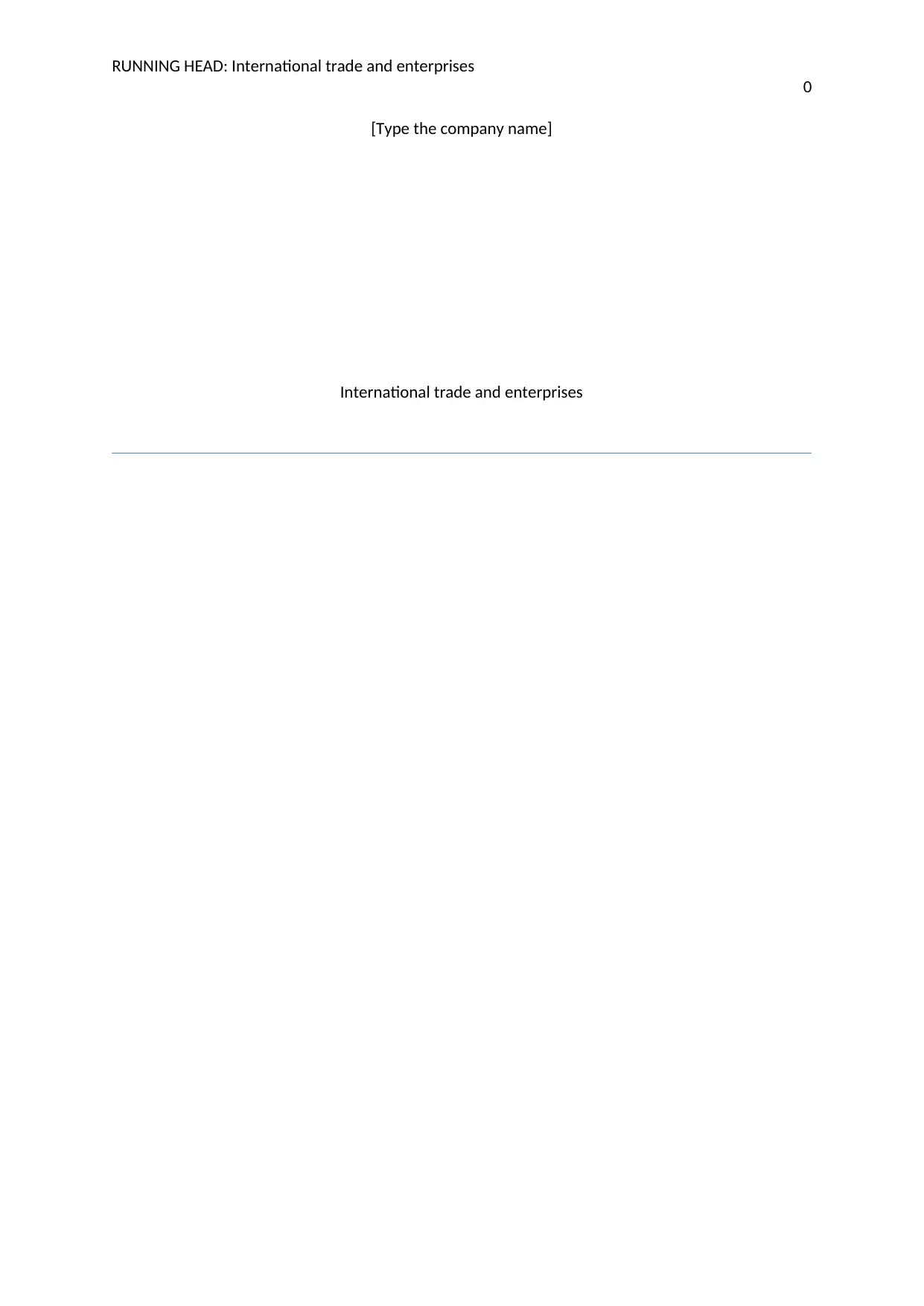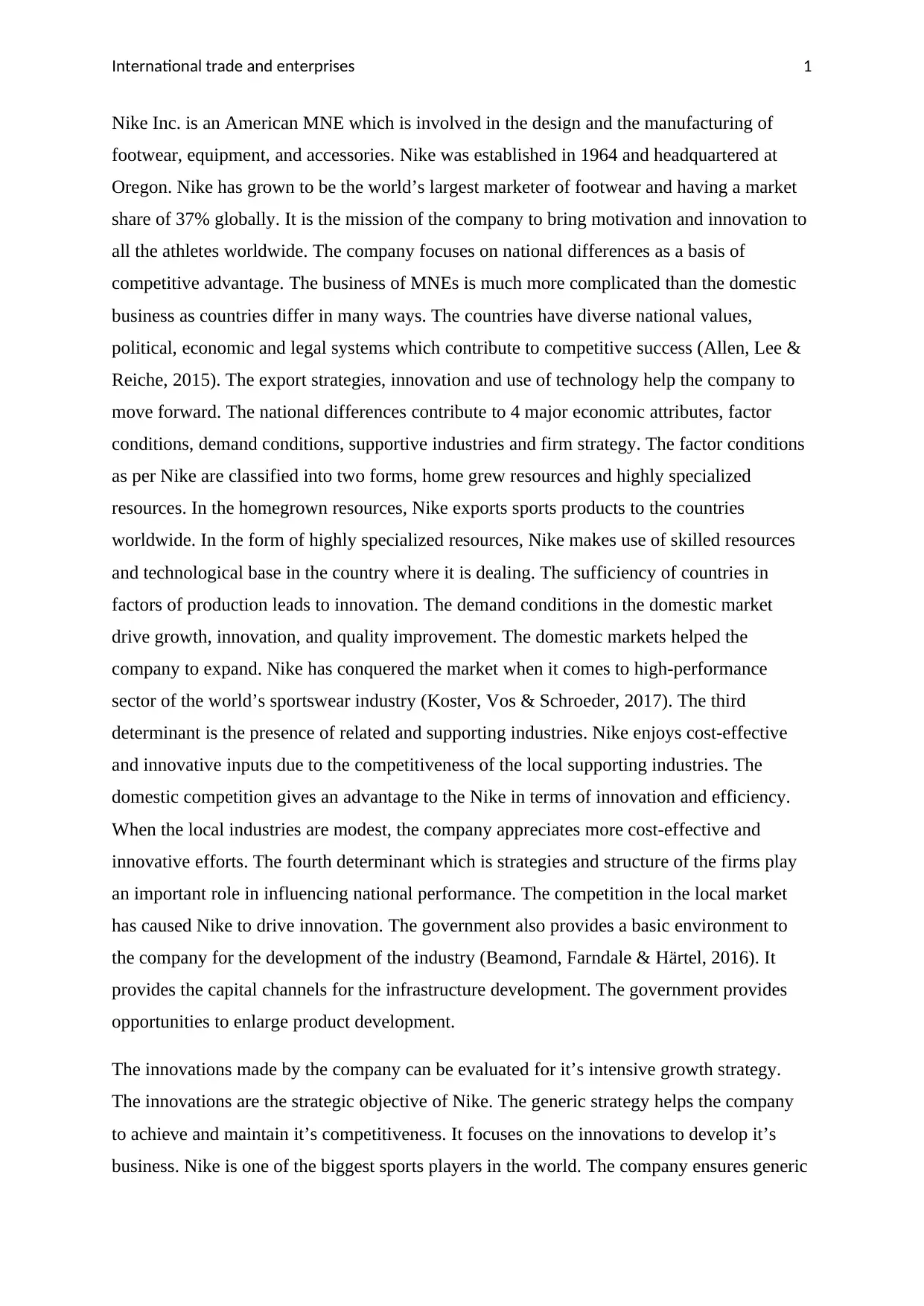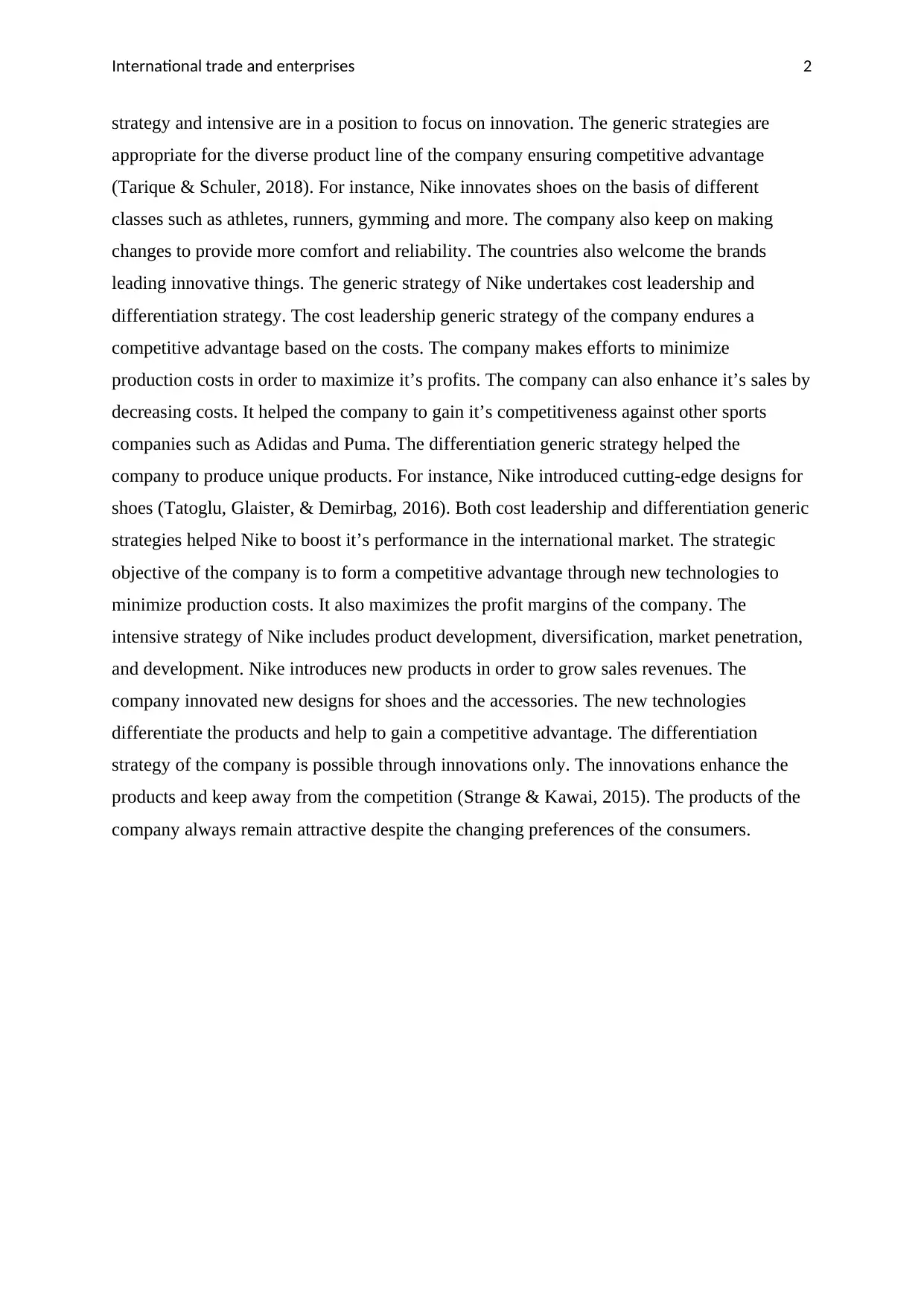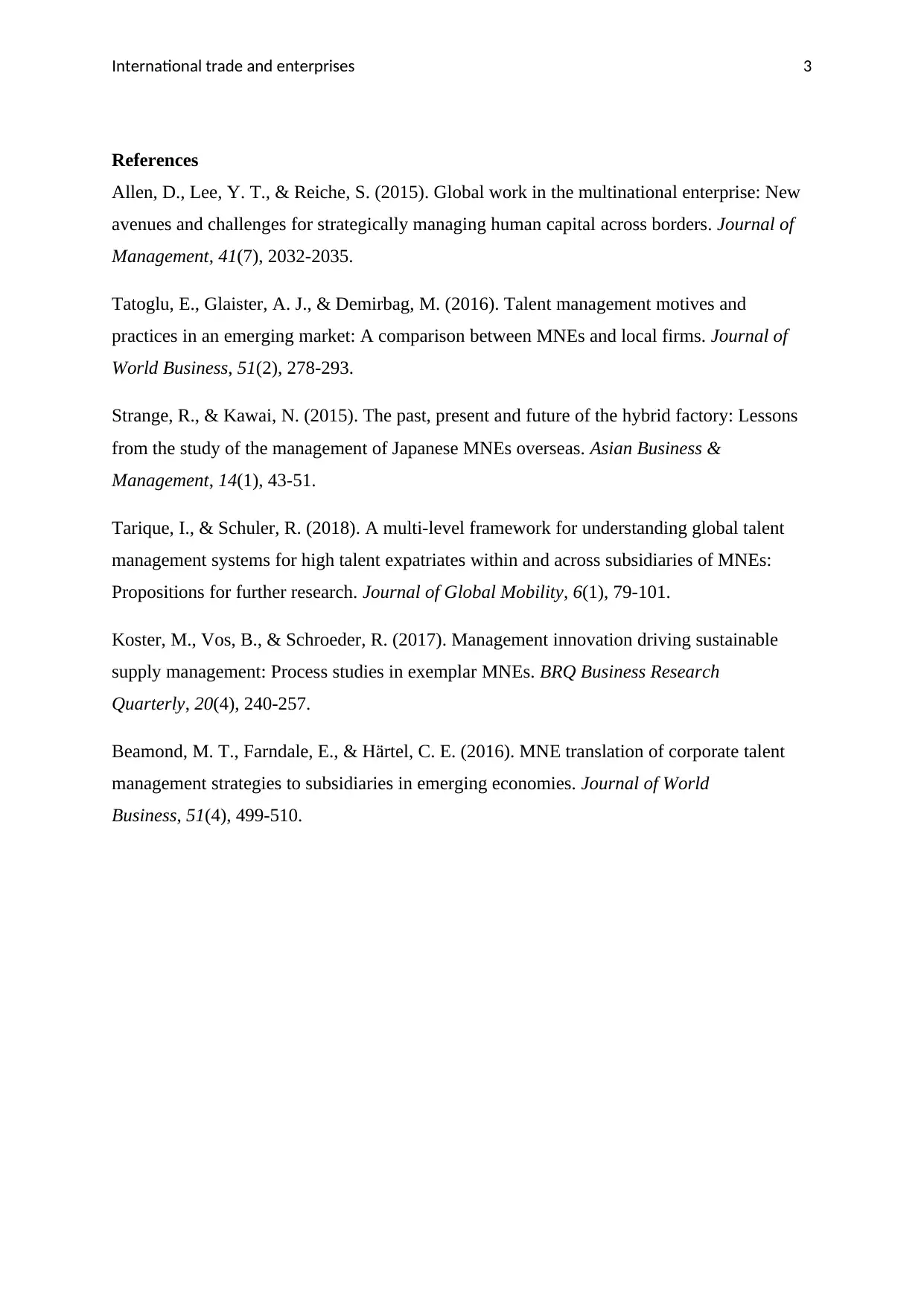Essay on Nike Inc.'s Competitive Advantage for IBUS90003, Sem 2
VerifiedAdded on 2023/06/07
|4
|1154
|367
Essay
AI Summary
This essay examines Nike Inc., an American multinational enterprise (MNE) specializing in footwear, equipment, and accessories, focusing on its competitive advantages in the international market. The essay analyzes how Nike leverages national differences, scale economies, and scope economies to achieve its competitive edge, particularly in the context of its global operations. It addresses which of the three strategic objectives (achieving efficiency, managing risks, and innovation, learning, and adaptation) the company addresses. The essay highlights Nike's strategies in terms of generic strategies like cost leadership and differentiation, and intensive strategies like product development, diversification, and market penetration, and its approach to innovation, technological advancements, and consumer preferences. The essay also references the company's mission to bring motivation and innovation to all the athletes worldwide. The analysis is supported by references to academic literature on international trade and MNE management, providing a comprehensive overview of Nike's strategic approach to international business.

RUNNING HEAD: International trade and enterprises
0
[Type the company name]
International trade and enterprises
0
[Type the company name]
International trade and enterprises
Paraphrase This Document
Need a fresh take? Get an instant paraphrase of this document with our AI Paraphraser

International trade and enterprises 1
Nike Inc. is an American MNE which is involved in the design and the manufacturing of
footwear, equipment, and accessories. Nike was established in 1964 and headquartered at
Oregon. Nike has grown to be the world’s largest marketer of footwear and having a market
share of 37% globally. It is the mission of the company to bring motivation and innovation to
all the athletes worldwide. The company focuses on national differences as a basis of
competitive advantage. The business of MNEs is much more complicated than the domestic
business as countries differ in many ways. The countries have diverse national values,
political, economic and legal systems which contribute to competitive success (Allen, Lee &
Reiche, 2015). The export strategies, innovation and use of technology help the company to
move forward. The national differences contribute to 4 major economic attributes, factor
conditions, demand conditions, supportive industries and firm strategy. The factor conditions
as per Nike are classified into two forms, home grew resources and highly specialized
resources. In the homegrown resources, Nike exports sports products to the countries
worldwide. In the form of highly specialized resources, Nike makes use of skilled resources
and technological base in the country where it is dealing. The sufficiency of countries in
factors of production leads to innovation. The demand conditions in the domestic market
drive growth, innovation, and quality improvement. The domestic markets helped the
company to expand. Nike has conquered the market when it comes to high-performance
sector of the world’s sportswear industry (Koster, Vos & Schroeder, 2017). The third
determinant is the presence of related and supporting industries. Nike enjoys cost-effective
and innovative inputs due to the competitiveness of the local supporting industries. The
domestic competition gives an advantage to the Nike in terms of innovation and efficiency.
When the local industries are modest, the company appreciates more cost-effective and
innovative efforts. The fourth determinant which is strategies and structure of the firms play
an important role in influencing national performance. The competition in the local market
has caused Nike to drive innovation. The government also provides a basic environment to
the company for the development of the industry (Beamond, Farndale & Härtel, 2016). It
provides the capital channels for the infrastructure development. The government provides
opportunities to enlarge product development.
The innovations made by the company can be evaluated for it’s intensive growth strategy.
The innovations are the strategic objective of Nike. The generic strategy helps the company
to achieve and maintain it’s competitiveness. It focuses on the innovations to develop it’s
business. Nike is one of the biggest sports players in the world. The company ensures generic
Nike Inc. is an American MNE which is involved in the design and the manufacturing of
footwear, equipment, and accessories. Nike was established in 1964 and headquartered at
Oregon. Nike has grown to be the world’s largest marketer of footwear and having a market
share of 37% globally. It is the mission of the company to bring motivation and innovation to
all the athletes worldwide. The company focuses on national differences as a basis of
competitive advantage. The business of MNEs is much more complicated than the domestic
business as countries differ in many ways. The countries have diverse national values,
political, economic and legal systems which contribute to competitive success (Allen, Lee &
Reiche, 2015). The export strategies, innovation and use of technology help the company to
move forward. The national differences contribute to 4 major economic attributes, factor
conditions, demand conditions, supportive industries and firm strategy. The factor conditions
as per Nike are classified into two forms, home grew resources and highly specialized
resources. In the homegrown resources, Nike exports sports products to the countries
worldwide. In the form of highly specialized resources, Nike makes use of skilled resources
and technological base in the country where it is dealing. The sufficiency of countries in
factors of production leads to innovation. The demand conditions in the domestic market
drive growth, innovation, and quality improvement. The domestic markets helped the
company to expand. Nike has conquered the market when it comes to high-performance
sector of the world’s sportswear industry (Koster, Vos & Schroeder, 2017). The third
determinant is the presence of related and supporting industries. Nike enjoys cost-effective
and innovative inputs due to the competitiveness of the local supporting industries. The
domestic competition gives an advantage to the Nike in terms of innovation and efficiency.
When the local industries are modest, the company appreciates more cost-effective and
innovative efforts. The fourth determinant which is strategies and structure of the firms play
an important role in influencing national performance. The competition in the local market
has caused Nike to drive innovation. The government also provides a basic environment to
the company for the development of the industry (Beamond, Farndale & Härtel, 2016). It
provides the capital channels for the infrastructure development. The government provides
opportunities to enlarge product development.
The innovations made by the company can be evaluated for it’s intensive growth strategy.
The innovations are the strategic objective of Nike. The generic strategy helps the company
to achieve and maintain it’s competitiveness. It focuses on the innovations to develop it’s
business. Nike is one of the biggest sports players in the world. The company ensures generic

International trade and enterprises 2
strategy and intensive are in a position to focus on innovation. The generic strategies are
appropriate for the diverse product line of the company ensuring competitive advantage
(Tarique & Schuler, 2018). For instance, Nike innovates shoes on the basis of different
classes such as athletes, runners, gymming and more. The company also keep on making
changes to provide more comfort and reliability. The countries also welcome the brands
leading innovative things. The generic strategy of Nike undertakes cost leadership and
differentiation strategy. The cost leadership generic strategy of the company endures a
competitive advantage based on the costs. The company makes efforts to minimize
production costs in order to maximize it’s profits. The company can also enhance it’s sales by
decreasing costs. It helped the company to gain it’s competitiveness against other sports
companies such as Adidas and Puma. The differentiation generic strategy helped the
company to produce unique products. For instance, Nike introduced cutting-edge designs for
shoes (Tatoglu, Glaister, & Demirbag, 2016). Both cost leadership and differentiation generic
strategies helped Nike to boost it’s performance in the international market. The strategic
objective of the company is to form a competitive advantage through new technologies to
minimize production costs. It also maximizes the profit margins of the company. The
intensive strategy of Nike includes product development, diversification, market penetration,
and development. Nike introduces new products in order to grow sales revenues. The
company innovated new designs for shoes and the accessories. The new technologies
differentiate the products and help to gain a competitive advantage. The differentiation
strategy of the company is possible through innovations only. The innovations enhance the
products and keep away from the competition (Strange & Kawai, 2015). The products of the
company always remain attractive despite the changing preferences of the consumers.
strategy and intensive are in a position to focus on innovation. The generic strategies are
appropriate for the diverse product line of the company ensuring competitive advantage
(Tarique & Schuler, 2018). For instance, Nike innovates shoes on the basis of different
classes such as athletes, runners, gymming and more. The company also keep on making
changes to provide more comfort and reliability. The countries also welcome the brands
leading innovative things. The generic strategy of Nike undertakes cost leadership and
differentiation strategy. The cost leadership generic strategy of the company endures a
competitive advantage based on the costs. The company makes efforts to minimize
production costs in order to maximize it’s profits. The company can also enhance it’s sales by
decreasing costs. It helped the company to gain it’s competitiveness against other sports
companies such as Adidas and Puma. The differentiation generic strategy helped the
company to produce unique products. For instance, Nike introduced cutting-edge designs for
shoes (Tatoglu, Glaister, & Demirbag, 2016). Both cost leadership and differentiation generic
strategies helped Nike to boost it’s performance in the international market. The strategic
objective of the company is to form a competitive advantage through new technologies to
minimize production costs. It also maximizes the profit margins of the company. The
intensive strategy of Nike includes product development, diversification, market penetration,
and development. Nike introduces new products in order to grow sales revenues. The
company innovated new designs for shoes and the accessories. The new technologies
differentiate the products and help to gain a competitive advantage. The differentiation
strategy of the company is possible through innovations only. The innovations enhance the
products and keep away from the competition (Strange & Kawai, 2015). The products of the
company always remain attractive despite the changing preferences of the consumers.
⊘ This is a preview!⊘
Do you want full access?
Subscribe today to unlock all pages.

Trusted by 1+ million students worldwide

International trade and enterprises 3
References
Allen, D., Lee, Y. T., & Reiche, S. (2015). Global work in the multinational enterprise: New
avenues and challenges for strategically managing human capital across borders. Journal of
Management, 41(7), 2032-2035.
Tatoglu, E., Glaister, A. J., & Demirbag, M. (2016). Talent management motives and
practices in an emerging market: A comparison between MNEs and local firms. Journal of
World Business, 51(2), 278-293.
Strange, R., & Kawai, N. (2015). The past, present and future of the hybrid factory: Lessons
from the study of the management of Japanese MNEs overseas. Asian Business &
Management, 14(1), 43-51.
Tarique, I., & Schuler, R. (2018). A multi-level framework for understanding global talent
management systems for high talent expatriates within and across subsidiaries of MNEs:
Propositions for further research. Journal of Global Mobility, 6(1), 79-101.
Koster, M., Vos, B., & Schroeder, R. (2017). Management innovation driving sustainable
supply management: Process studies in exemplar MNEs. BRQ Business Research
Quarterly, 20(4), 240-257.
Beamond, M. T., Farndale, E., & Härtel, C. E. (2016). MNE translation of corporate talent
management strategies to subsidiaries in emerging economies. Journal of World
Business, 51(4), 499-510.
References
Allen, D., Lee, Y. T., & Reiche, S. (2015). Global work in the multinational enterprise: New
avenues and challenges for strategically managing human capital across borders. Journal of
Management, 41(7), 2032-2035.
Tatoglu, E., Glaister, A. J., & Demirbag, M. (2016). Talent management motives and
practices in an emerging market: A comparison between MNEs and local firms. Journal of
World Business, 51(2), 278-293.
Strange, R., & Kawai, N. (2015). The past, present and future of the hybrid factory: Lessons
from the study of the management of Japanese MNEs overseas. Asian Business &
Management, 14(1), 43-51.
Tarique, I., & Schuler, R. (2018). A multi-level framework for understanding global talent
management systems for high talent expatriates within and across subsidiaries of MNEs:
Propositions for further research. Journal of Global Mobility, 6(1), 79-101.
Koster, M., Vos, B., & Schroeder, R. (2017). Management innovation driving sustainable
supply management: Process studies in exemplar MNEs. BRQ Business Research
Quarterly, 20(4), 240-257.
Beamond, M. T., Farndale, E., & Härtel, C. E. (2016). MNE translation of corporate talent
management strategies to subsidiaries in emerging economies. Journal of World
Business, 51(4), 499-510.
1 out of 4
Related Documents
Your All-in-One AI-Powered Toolkit for Academic Success.
+13062052269
info@desklib.com
Available 24*7 on WhatsApp / Email
![[object Object]](/_next/static/media/star-bottom.7253800d.svg)
Unlock your academic potential
Copyright © 2020–2025 A2Z Services. All Rights Reserved. Developed and managed by ZUCOL.




